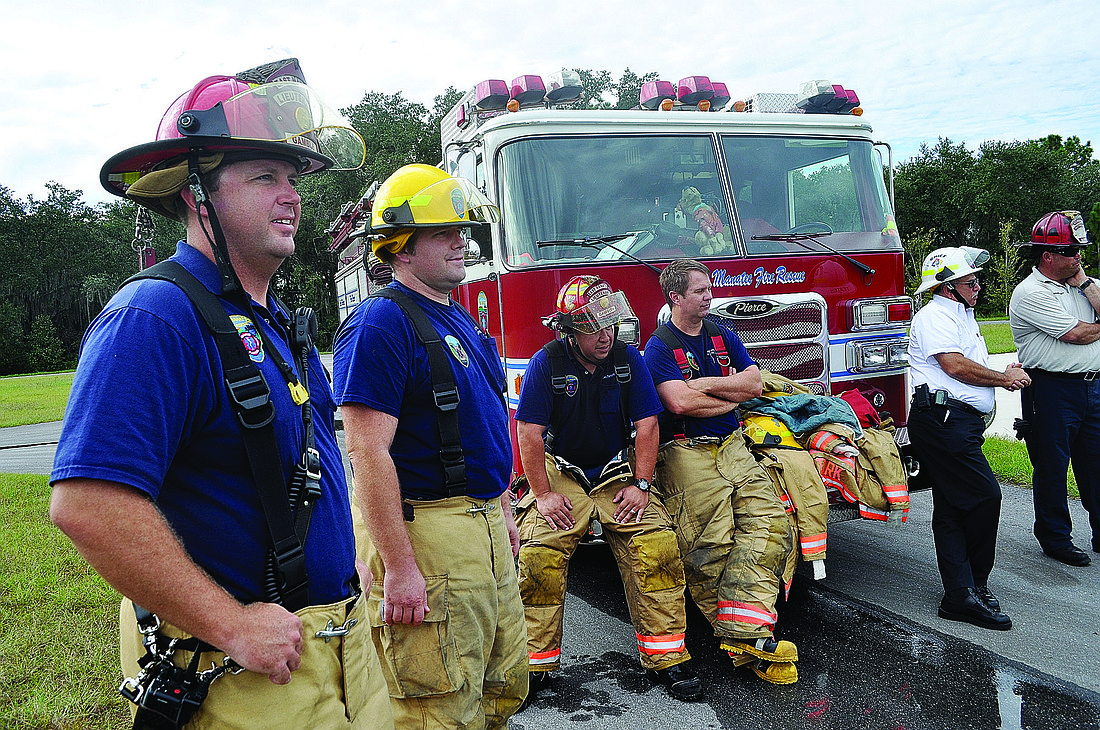- April 15, 2024
-
-
Loading

Loading

EAST COUNTY — Jesse Salain slipped on black gloves while struggling to squeeze into a wet coat.
Fully geared in a plastic yellow hat and an oxygen mask with a 30-pound air tank on his back, Salain, a fireman at East Manatee Fire Department, slowly walked — as he’s trained to do — to the pipes’ leaking fluid.
If this were real life, the pipes would be spewing hazardous liquid, and Salain would be rescuing people.
But, because this is practice, Salain only fought water and he saved no one.
Still, after he clamped the leaks and walked back to his crew waiting in the cold zone by the fire truck, he used a cloth to wipe his sweaty face, dropped his now-heavier coat to the ground and remarked to no one in particular, “It’s harder than it looks.”
The East Manatee Fire Department calls this process “hazardous-leaks training,” and from Nov. 6 to Nov. 8, 63 firefighters split into three shifts to learn how to stop leaking fluids.
Tim Hyden, a training/safety officer at the East Manatee Fire Department, says the district is being proactive in stomping out liquid leaks, including flammable liquids and gas leaks, a threat that has grown in recent years (see sidebar).
All of East Manatee’s firefighters possess operational-level skills to respond to such incidents, meaning they can rescue people and pull them away from the hazardous material — without actually stopping the leak.
East Manatee wants its force to be at a technician level, which requires 160 hours of training, so they can “plug that hole, turn off that valve, and crip that gas line to stop the leak,” Hyden says.
Prior to the training, led by Mike Bloski of Hot Zone USA, the majority of the fire department’s frontline employees did not possess these high-level skills.
East Manatee will conduct follow-up training, specific to gas line breaks, in January.
“Typically, when you think of what we do, you think of us responding to a fire-related or medical-related incident,” Hyden said. “Hazardous-material leaking incidents do not happen often, but when they do, we have to know what we are doing. Unfortunately, breaking gas lines by accident is often a byproduct of the digging that goes with commercial and residential construction.”
Beyond broken gas lines, a major thoroughfare within the district also presents a challenge.
Parts of Interstate 75, State Road 70 and State Road 64 make up East Manatee Fire’s coverage area and, often enough, tankers carrying hazardous material flip over, requiring firefighter response.
East County has become highly industrialized, and sometimes firefighters respond to 50- to 60-gallon drums — which are used in food, powder and liquid industries to hold materials — leaking inside a business.
Although some of the firemen already have such skills, and at least one person on a responding unit can stop leaks, the goal is to get more firefighters trained to be able to respond.
When they get called for a dangerous situation, Hyden said staff need all the skills available to help.
“It’s very difficulty to tell someone, ‘You can’t do that because you’re not trained,’” Hyden said.
“Emergency personnel have it in their hard drive to take care of a situation, and for them to do that, we want to make sure they are all trained to a safe level.”
By the numbers
Number of responses to hazardous material leaks:
Flammable liquids (these are often small fuel spills at gas stations):
2011: 7
2012: 22
2013: 11 (through Nov. 14)
Gas leaks (typically gas line breaks at under-construction developments):
2011: 11
2012: 13
2013: 21 (through Nov. 14)
Contact Josh Siegel at [email protected].